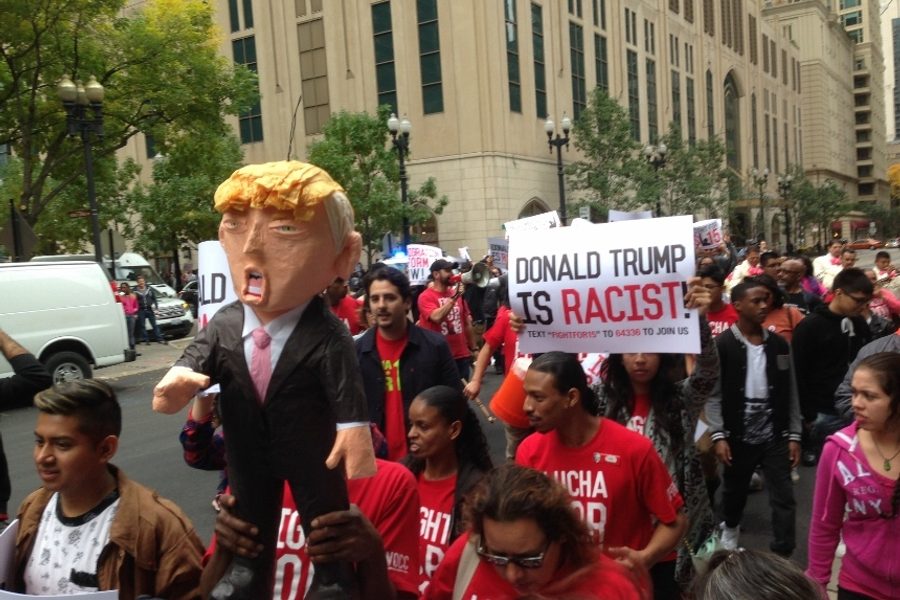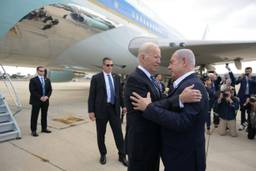Fight for 15 Activists Spend Columbus Day Rallying Against “Racist” Donald Trump
Branko Marcetic

Two months ago, on a Chicago architectural boat tour, my tour guide joked to the audience while floating past the Trump International Hotel and Tower in downtown Chicago that they were looking at a building owned by the future president of the United States. His words were met with howls of laughter. Now, Donald Trump leads the Republican presidential field by a wide margin, and his candidacy is no longer a laughing matter.
Perhaps this is partly what animated more than 200 workers, students and activists who rallied on Monday at a carpenters union hall in downtown Chicago to protest what they say is overt racism and xenophobia in Trump’s campaign, as well as to call for immigration reform.
The Fight for 15-organized protest, coinciding with Columbus Day, saw demonstrators toting a Donald Trump piñata march to the billionaire mogul’s hotel with a mariachi band in tow. Featuring Trump’s signature combover and its mouth contorted into a trumpet player’s puckered embouchure, the GOP frontrunner’s papier mâché doppelganger was filled with the names of people who had signed onto a statement opposing his rhetoric and policies. (Each person who signed the statement was also entered into the draw to win a Trump piñata of their own).
The protest was at turns festive and angry, with participants denouncing the racist rhetoric thrown around by Trump that is often aimed at Hispanics, but has also landed at times on African Americans.
“Black and brown people are tired of being disrespected,” said Tyree Johnson, a Fight for 15 leader. “Donald Trump is racist and doesn’t deserve to be president.”
Oscar Torres, a member of the mariachi band that came down to support the protest, was even more blunt.
“I don’t like Trump,” he said. “Trump is bullshit.”
Meanwhile, Nicholas Chango, an activist and descendent of the Incan people, gave a fiery speech outside of the carpenters hall where the protest began, denouncing Trump as the modern embodiment of the conquistadors responsible for the genocide of indigenous peoples centuries ago.
“The kind of racism that Trump represents — [he] can’t ever be a candidate,” he said later.
Given Trump’s racist rhetoric, it’s hardly a surprise that his popularity with non-white voters, particularly Latinos, has been abysmal since his campaign began. In September, a Washington Post/ABC poll revealed 82 percent of Hispanic voters viewed him unfavorably. Trump’s standing among what he calls “the blacks” is quite possibly even worse, with an August poll from Quinnipiac University finding 79 percent had an unfavorable view of the real estate tycoon, and only 3 percent said they would vote for him.
Yet a recent Pew poll also found that Trump is easily the most popular candidate among Republican and Republican-leaning voters across just about every population segment, including those making less than $40,000 a year, with whom he has over 20 more points worth of support than the next most popular candidate.
One Trump-leaning voter, Wayne, who was visiting Chicago from New Orleans, stood outside the Trump hotel’s entrance on Wabash Avenue on Monday watching the Fight for 15 protesters march past. The Trump piñata led the way, carried high in the air at the front of the procession like a mascot, as demonstraters chanted and brandished signs declaring Trump a racist.
Although Wayne was an undecided voter, he liked Trump, citing his willingness to fearlessly talk about topics that other candidates wouldn’t touch.
“Donald Trump has been his own personality since he was Donald Trump,” he said, “He’s not supported by outside vendors. He’s not worried about offending anyone, ‘cause he’s got his own money.”
“Immigrant rights are workers’ rights”
Trump’s candidacy wasn’t the sole focus of the October 12 protest. Demonstrators brought together a number of issues that reflect the Fight for 15 campaign’s efforts to build a broad coalition representing a number of interests. Throughout the day, participants spoke on — and marched against — subjects that ran the gamut from racism and indigenous rights to, most prominently, the plight of undocumented migrants.
The day started with a town hall meeting run by Communities United, a grassroots community organization focused on social, racial and economic injustice and whose members later joined in the Fight for 15 action. The organization’s speakers, black and Latino high school students from a number of local communities, spoke passionately against the daily racism faced by people of color in America, and called for reform of the country’s immigration system.
One speaker, Valentina, an undocumented immigrant brought to the United States when she was two years old, described the Kafkaesque predicament she faced. To apply for work authorization under Deferred Action for Childhood Arrivals, a program that allows undocumented immigrants who came to the United States as children to defer their deportation, she needed money. But to get money, she needed a job. And without work authorization, she was legally unable to get a job or even apply for a social security number, which she needs to work.
For participants, these matters were part of the same struggle.
“Immigrants make millions of dollars for corporations and fast food companies, but even then, we’re still poor, and they treat us like second-class citizens,” one speaker, Cecilia, told the crowd in the carpenters hall. Without immigration reform, she added, workers won’t have a real victory.
Veteran activist Jorge Mújica Murias, who helped organize Chicago’s massive 2006 immigrant protest against federal legislation that would have made illegal immigration a felony, spoke to reporters in a similar vein before the march.
“Work is the number one reason for immigration,” Mújica, who is an organizer at Arise Chicago Worker Center, said. He was standing against anti-black racism as well, he added, because African-Americans “are workers too.”
Many speakers talked about the collective fear their communities experienced on a daily basis: fear of police, of racial profiling, of making it from one paycheck to the next and of they or their family members being deported. Antonio Magitt, a junior from Roosevelt High School who MC’ed the Communities United event, called for solidarity between black and brown youth fighting for social justice.
A straight-A student whose dark hair is speckled with orange highlights, he recounted how he had gotten into activism, attending a recent walkout protest against a number of recent firings at his school. Singled out by a police officer and security guard because of his race, he was slammed against a table, handcuffed, charged with resisting arrest and called a “gang banger.” It was an experience that many at the protest could relate to.
A coalition of the dispossessed
The October 12 action is the first of three that will take place in Chicago building up to a national day of action on November 10 called for by Fight for 15. Much as Monday’s protest brought together different strains of activism, such as immigration reform and anti-racism, so the following two will interlink with other movements, such as a November 2 protest that will be held in solidarity with Black Lives Matter.
Ironically, Fight for 15’s efforts to build solidarity across different marginalized groups, some of whom are targeted by Trump, is perhaps made possible by him, too. Latino activists have previously noted that Trump’s campaign is helping mobilize Latinos, who are infuriated by everything from the billionaire’s anti-Mexican comments to his anti-immigrant policies.
If so, even if Fight for 15 achieves its chief goal of raising the minimum wage, the movement it creates may live on well after its dissolution, capitalizing on the anger felt by those left behind by society, public institutions and politicians.
“All these slogans about making America great again,” said Magitt, as he marched to Trump’s tower; “and they’re doing nothing.”
Branko Marcetic is a staff writer at Jacobin magazine and a 2019-2020 Leonard C. Goodman Institute for Investigative Reporting fellow. He is the author of Yesterday’s Man: The Case Against Joe Biden.








